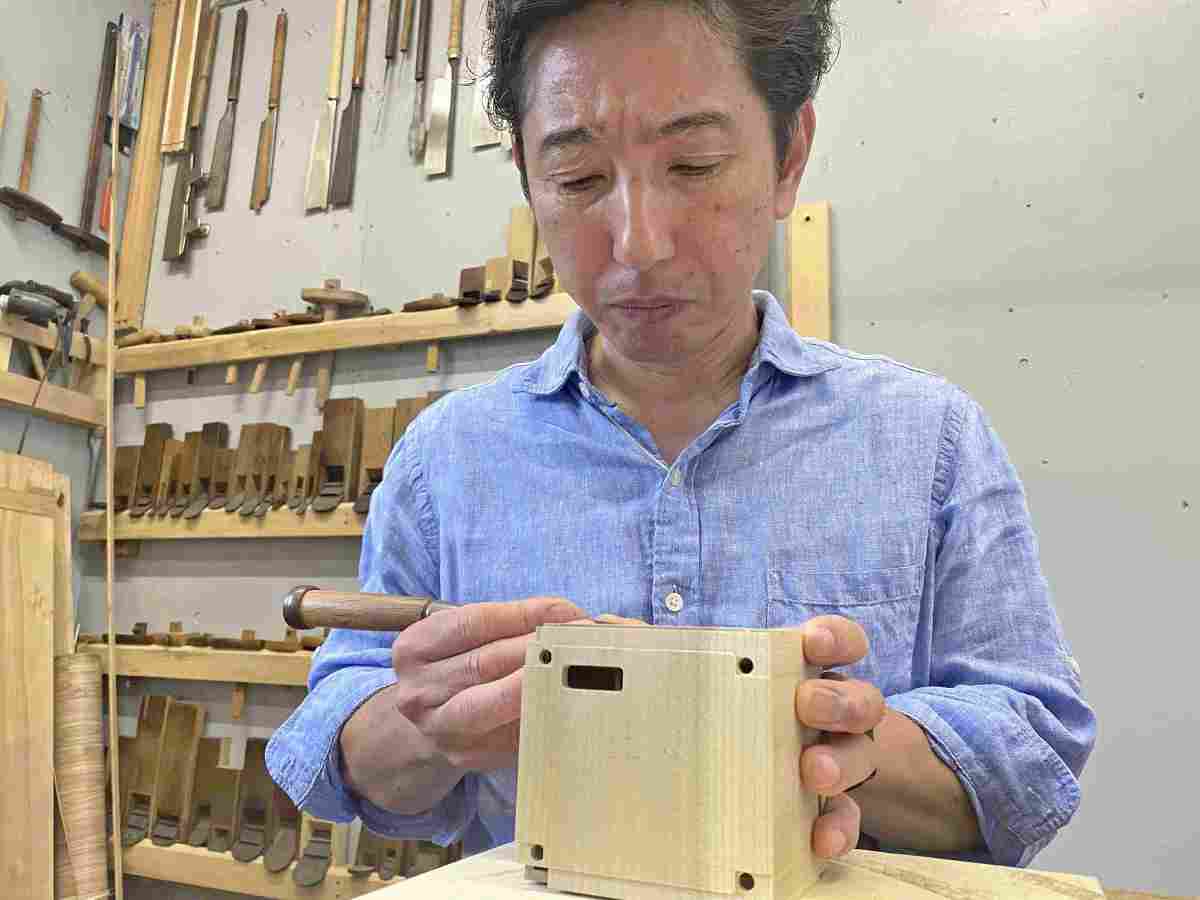
An artist rendering of a wooden satellite being developed by Kyoto University and other entities.
13:42 JST, June 20, 2023
Kyoto University has partnered with various companies to launch the world’s first wooden satellite, which will be built using traditional Japanese carpentry techniques. It is set to be launched from the United States in March 2024.
Kuroda Kobo, a woodworking company in Otsu that usually restores cultural assets including national treasures, is part of the team and is currently constructing the 10-centimeter square cube. The part, which needs to be completed by the end of the month, can only have a margin of error of 0.01 millimeters.
“We need to make sure it’s the best it can be so that it can withstand the conditions of space,” said Kuroda Kobo President Hiroaki Usui, 51, as he shaved down a piece of Japanese big-leaf magnolia.

Kuroda Kobo President Hiroaki Usui makes a wooden satellite part using a traditional Japanese joinery technique.
While measuring the warp and moisture content of the wood, he spent half a month shaving the plate down to 5.5 millimeters.
Kuroda Kobo was brought in as part of the development team in 2019 by a Kyoto University professor.
The company decided to take on the challenge of helping to build the world’s first wooden satellite. In recent years, many small satellites have been launched for various purposes, including improving communications. By using wood to build the body of the satellite, the team aims to reduce the number of metal particles generated when the satellite burns up upon entry into the atmosphere after completing its mission, thereby reducing its impact on the environment.
Japanese magnolia has been used to make such items as Japanese sword sheaths and woodblocks due to its light weight, easy processability and uniform density, which prevents deformations. The wood was chosen after Kyoto University, Sumitomo Forestry Co. and other groups conducted tests to determine which types showed less signs of deterioration after being exposed to cosmic rays outside of the International Space Station for about 300 days.
The team also had to select a wood that was highly durable. The satellite will be exposed to the vacuum of space, removing any moisture in the wood. It will also need to withstand extreme temperature changes, between 120 C and minus 150 C, as it completes its orbit around the Earth every 90 minutes. These changes would cause the wood to expand and contract, as well as suffer damage if glue or other such materials are used.

A traditional Japanese joinery technique
In light of this, a traditional joinery technique called “tomegata kakushi arigumi,” which is used to make paulownia chests, drawers and other items, has been adopted. The technique requires protrusions to be cut out, allowing the pieces to tightly fit together like puzzle pieces without the use of nails or adhesives.
The thickness of the wood was determined based on various factors, including how much weight the rocket could safely carry. The U.S. National Aeronautics and Space Administration (NASA) requires dimensional deformations be kept to 0.01 millimeters and approved the use of Japanese magnolia in May. The wood pieces have to be completed by the end of June in order to launch the satellite by March next year.
“We’re struggling to maintain a margin of error of 0.01 millimeters, a challenge that no one has undertaken before,” said Usui. “We’ve also paid very careful attention to atmospheric conditions to prevent the wood from shrinking due to humidity.”
NASA and the Japan Aerospace Exploration Agency (JAXA) plan to conduct a final safety check in October. If it passes the test, the wooden satellite will be scheduled to be launched to the ISS in March.
“Since there’s no concern about wood rotting in space, with its lack of rain, insects or bacteria, it holds promise as a material for future space development,” said team leader Takao Doi, 68, an astronaut and program-specific Kyoto University professor.
Usui said, “We hope to successfully develop the latest wooden satellite using traditional Japanese techniques.”
"Science & Nature" POPULAR ARTICLE
-

Mass Oyster Die-Offs Confirmed in Japan’s Seto Inland Sea; High Water Temperature Cited as Primary Cause
-

Genome Study Reveals Milestone in History of Cat Domestication
-

Big Leap in Quest to Get to Bottom of Climate Ice Mystery
-

Security Camera Footage Vulnerable to Outside Access; Investigation Finds 3,000 Pieces Exposed Online
-

Paws on Parade: Nairobi’s Dogs Dazzle at ‘Pawchella’
JN ACCESS RANKING
-

Keidanren Chairman Yoshinobu Tsutsui Visits Kashiwazaki-Kariwa Nuclear Power Plant; Inspects New Emergency Safety System
-

Imports of Rare Earths from China Facing Delays, May Be Caused by Deterioration of Japan-China Relations
-

University of Tokyo Professor Discusses Japanese Economic Security in Interview Ahead of Forum
-

Japan Pulls out of Vietnam Nuclear Project, Complicating Hanoi’s Power Plans
-

Govt Aims to Expand NISA Program Lineup, Abolish Age Restriction


























